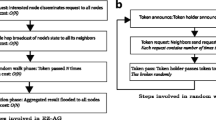Abstract
Selective families of sets, or selectors, are combinatorial tools used to “isolate” individual members of sets from some set family. Given a set X and an element \(x\in X\), to isolate x from X, at least one of the sets in the selector must intersect X on exactly x. We study \((k,N)\)-permutation selectors which have the property that they can isolate each element of each k-element subset of \({ \left\{ {0,1,...,N-1} \right\} }\) in each possible order. These selectors can be used in protocols for ad-hoc radio networks to more efficiently disseminate information along multiple hops. In 2004, Gasieniec, Radzik and Xin gave a construction of a \((k,N)\)-permutation selector of size \(O(k^2\log ^3 N)\). This paper improves this by providing a probabilistic construction of a \((k,N)\)-permutation selector of size \(O(k^2\log N)\). Remarkably, this matches the asymptotic bound for standard strong \((k,N)\)-selectors, that isolate each element of each set of size k, but with no restriction on the order. We then show that the use of our \((k,N)\)-permutation selector improves the best running time for gossiping in ad-hoc radio networks by a poly-logarithmic factor.
Research supported by NSF grant CCF-2153723.
Access this chapter
Tax calculation will be finalised at checkout
Purchases are for personal use only
Similar content being viewed by others
References
Basagni, S., Bruschi, D., Chlamtac, I.: A mobility-transparent deterministic broadcast mechanism for ad hoc networks. IEEE/ACM Trans. Networking 7(6), 799–807 (1999)
Chaudhuri, S., Radhakrishnan, J.: Deterministic restrictions in circuit complexity. In: Proceedings of the Twenty-Eighth Annual ACM Symposium on Theory of Computing, STOC 1996, pp. 30–36. Association for Computing Machinery, New York (1996)
Chlebus, B.S., Gasieniec, L., Gibbons, A., Pelc, A., Rytter, W.: Deterministic broadcasting in ad hoc radio networks. Distrib. Comput. 15(1), 27–38 (2002)
Chrobak, M., Gasieniec, L., Rytter, W.: Fast broadcasting and gossiping in radio networks. J. Algorithms 43(2), 177–189 (2002)
Clementi, A.E.F., Monti, A., Silvestri, R.: Distributed broadcast in radio networks of unknown topology. Theor. Comput. Sci. 302(1–3), 337–364 (2003)
Czumaj, A., Davies, P.: Faster deterministic communication in radio networks. In: Proceedings of 43rd International Colloquium on Automata, Languages, and Programming (ICALP 2016), pp. 139:1–139:14 (2016)
De Bonis, A., Gąsieniec, L., Vaccaro, U.: Generalized framework for selectors with applications in optimal group testing. In: Baeten, J.C.M., Lenstra, J.K., Parrow, J., Woeginger, G.J. (eds.) ICALP 2003. LNCS, vol. 2719, pp. 81–96. Springer, Heidelberg (2003). https://doi.org/10.1007/3-540-45061-0_8
D’yachkov, A., Rykov, V.: Bounds on the length of disjunctive codes. Probl. Inf. Transm. 18, 7 (1982)
Erdös, P., Frankl, P., Füredi, Z.: Families of finite sets in which no set is covered by the union of \(r\) others. Israel J. Math. 51(1–2), 79–89 (1985)
Gasieniec, L., Radzik, T., Xin, Q.: Faster deterministic gossiping in directed ad hoc radio networks. In: Proceedings of Scandinavian Workshop on Algorithm Theory (SWAT 2004), pp. 397–407 (2004)
Hwang, F.K., Sos, V.T.: Non-adaptive hypergeometric group testing. Studia Scientiarum Mathematicarum Hungarica 22, 257–263 (1987)
Kautz, W.H., Singleton, R.C.: Nonrandom binary superimposed codes. IEEE Trans. Inf. Theory 10(4), 363–377 (1964)
Komlos, J., Greenberg, A.: An asymptotically fast nonadaptive algorithm for conflict resolution in multiple-access channels. IEEE Trans. Inf. Theory 31(2), 302–306 (1985)
Liu, D., Prabhakaran, M.: On randomized broadcasting and gossiping in radio networks. In: Proceedings of 8th Annual International Conference on Computing and Combinatorics (COCOON 2002), pp. 340–349 (2002)
De Marco, G.: Distributed broadcast in unknown radio networks. SIAM J. Comput. 39(6), 2162–2175 (2010)
Porat, E., Rothschild, A.: Explicit nonadaptive combinatorial group testing schemes. IEEE Trans. Inf. Theory 57(12), 7982–7989 (2011)
Romik, D.: The Surprising Mathematics of Longest Increasing Subsequences. Cambridge University Press (2014)
Author information
Authors and Affiliations
Corresponding author
Editor information
Editors and Affiliations
Rights and permissions
Copyright information
© 2025 The Author(s), under exclusive license to Springer Nature Switzerland AG
About this paper
Cite this paper
Kuschner, J., Shashwat, Y., Yadav, S., Chrobak, M. (2025). On Permutation Selectors and their Applications in Ad-Hoc Radio Networks Protocols. In: Bramas, Q., Casteigts, A., Meeks, K. (eds) Algorithmics of Wireless Networks. ALGOWIN 2024. Lecture Notes in Computer Science, vol 15026. Springer, Cham. https://doi.org/10.1007/978-3-031-74580-5_8
Download citation
DOI: https://doi.org/10.1007/978-3-031-74580-5_8
Published:
Publisher Name: Springer, Cham
Print ISBN: 978-3-031-74579-9
Online ISBN: 978-3-031-74580-5
eBook Packages: Computer ScienceComputer Science (R0)




